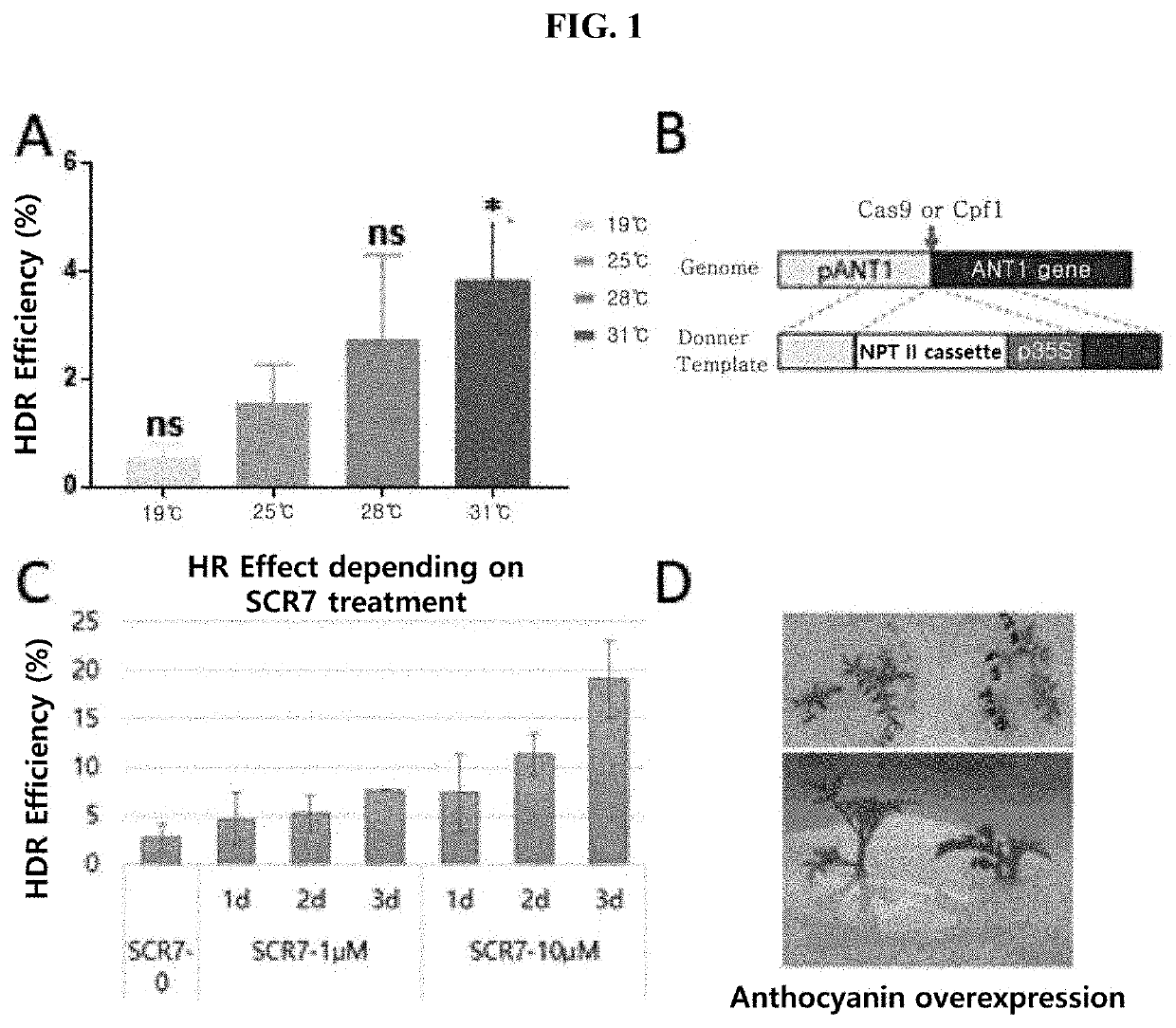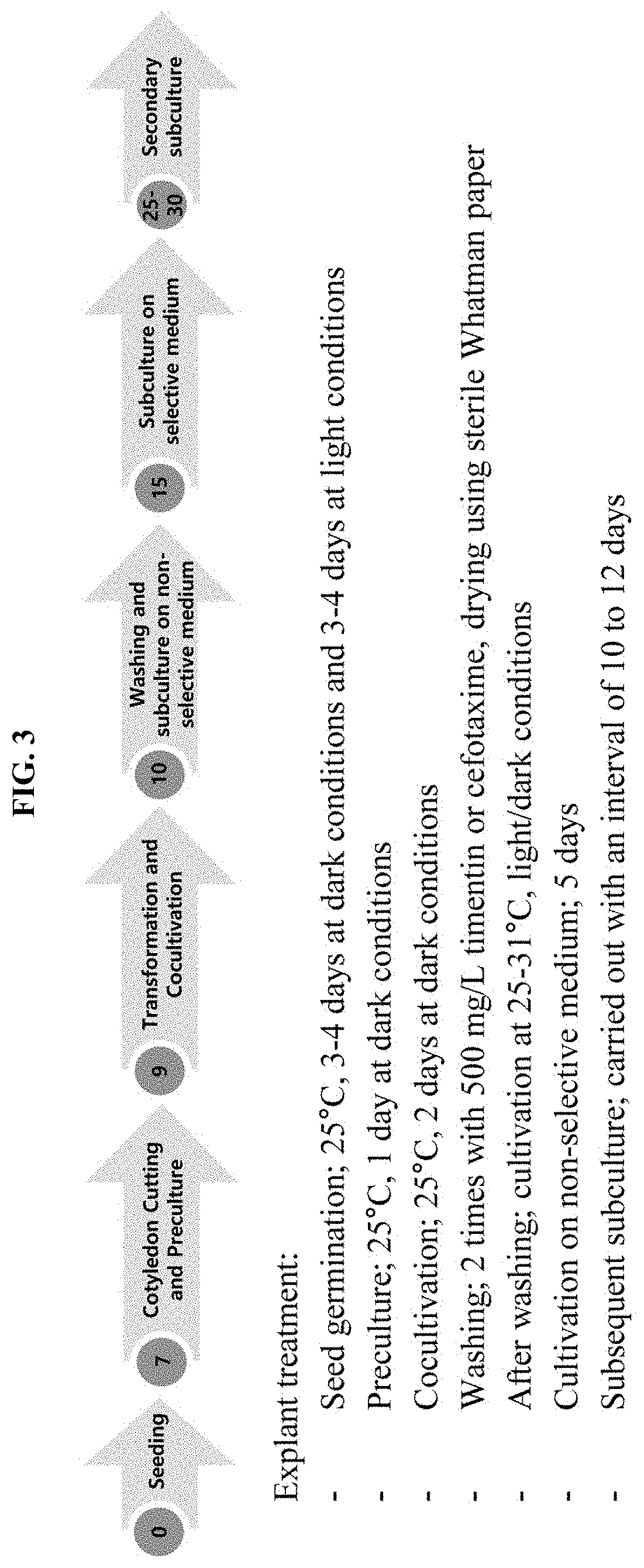Method for increasing efficiency of homologous recombination-based gene editing in plant
- Summary
- Abstract
- Description
- Claims
- Application Information
AI Technical Summary
Benefits of technology
Problems solved by technology
Method used
Image
Examples
example 1
of Homologous Recombination Efficiency Using Anthocyanin Marker
[0063]To examine the efficiency of HDR-based gene scissors in tomato, to the upstream promoter site of the transcription initiation site of ANT1 gene, which is a transcription factor regulating the anthocyanin synthesis, 35S promoter was inserted via HDR so that forming of purple-colored callus was induced based on anthocyanin overexpression resulting from the activation of ANT1 gene.
[0064]HDR template (SEQ ID NO. 29) was designed such that 35S promoter nucleotide sequence and pNos-NPTII-OCSt are inserted, at the upstream of the promoter, to have kanamycin resistance at the time of HDR event. In this case, the upper nucleotide sequence was 1,043 bp and the lower nucleotide sequence was 592 bp, in which the both nucleotides have sequence homology. In addition, two TALEN binding sites or dSaCas9 (D10A, N580A) / gRNA sites were added to the upstream region. For DNA double strand break, SpCas9 (Streptococcus pyogenes Cas9) / gRN...
example 2
Plant Homologous Recombination Frequency According to SCR7 Pyrazine Treatment
[0069]DNA repair is mostly achieved by NHEJ pathway, and HDR-based repair occurs very limitedly. According to previous studies made on mammals, it was reported that HDR efficiency can be increased by blocking the NHEJ pathway. It is reported that SCR7 pyrazine, which is an inhibitor of mammalian ligase IV, can increase HDR as much as about 19 times in mouse, or 5 times in human cell line. With regard to a plant, Nishizawa-Yokoi et. al. suggested that ligase IV plays an important role in NHEJ pathway in rice (2016, Plant Physiol. 170 (2): 653-666). However, no report has been made regarding the influence of SCR7 pyrazine on plant HDR. Accordingly, the effect of a treatment with different cultivation period (0, 1, 2 or 3 days) or different SCR7 pyrazine concentration (0, 1, 10 μM) was examined by the inventors of the present invention by using Cas9 structure pTC217 (BeYDV having Cas9 / gRNA1b). As a result, it ...
example 3
attern of Release of BeYDV Replication Replicon
[0072]The inventors of the present invention found the optimum time point of the maximum release of circular BeYDV replicon in Agrobacterium-infected tomato cotyledon system. Virus replicon tends to get expressed in circular form from a liner T-DNA which is delivered to a nucleus of plant cell, and, according to rolling circle replication, it is amplified to several hundred to several thousand copies per cell. Kinetic information about the maximum replicon release may provide information regarding the optimum time point for applying small molecules to a tissue culture system. To study the kinetic pattern of replicon release, cotyledon was transfected with Agrobacterium containing BeYDV vector pLSL.GFP.R (Cermak et. al., 2015) and pLSL.R.GGFP and non-virus vector pAGM4723. Circular virus was detected from the infected cotyledon, in which the detection is made by PCR analysis using specific primers which can amplify the junction part of t...
PUM
| Property | Measurement | Unit |
|---|---|---|
| Temperature | aaaaa | aaaaa |
| Temperature | aaaaa | aaaaa |
| Time | aaaaa | aaaaa |
Abstract
Description
Claims
Application Information
 Login to View More
Login to View More - R&D
- Intellectual Property
- Life Sciences
- Materials
- Tech Scout
- Unparalleled Data Quality
- Higher Quality Content
- 60% Fewer Hallucinations
Browse by: Latest US Patents, China's latest patents, Technical Efficacy Thesaurus, Application Domain, Technology Topic, Popular Technical Reports.
© 2025 PatSnap. All rights reserved.Legal|Privacy policy|Modern Slavery Act Transparency Statement|Sitemap|About US| Contact US: help@patsnap.com



